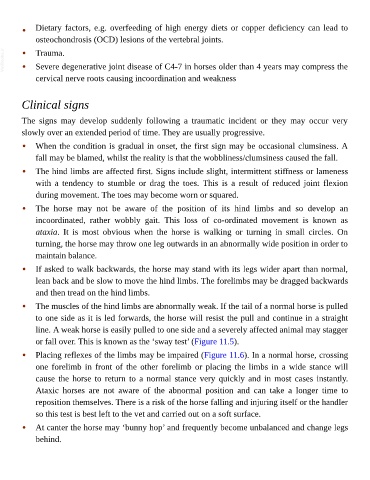Page 486 - The Veterinary Care of the Horse
P. 486
• Dietary factors, e.g. overfeeding of high energy diets or copper deficiency can lead to
osteochondrosis (OCD) lesions of the vertebral joints.
VetBooks.ir • Trauma.
•
Severe degenerative joint disease of C4-7 in horses older than 4 years may compress the
cervical nerve roots causing incoordination and weakness
Clinical signs
The signs may develop suddenly following a traumatic incident or they may occur very
slowly over an extended period of time. They are usually progressive.
• When the condition is gradual in onset, the first sign may be occasional clumsiness. A
fall may be blamed, whilst the reality is that the wobbliness/clumsiness caused the fall.
• The hind limbs are affected first. Signs include slight, intermittent stiffness or lameness
with a tendency to stumble or drag the toes. This is a result of reduced joint flexion
during movement. The toes may become worn or squared.
• The horse may not be aware of the position of its hind limbs and so develop an
incoordinated, rather wobbly gait. This loss of co-ordinated movement is known as
ataxia. It is most obvious when the horse is walking or turning in small circles. On
turning, the horse may throw one leg outwards in an abnormally wide position in order to
maintain balance.
• If asked to walk backwards, the horse may stand with its legs wider apart than normal,
lean back and be slow to move the hind limbs. The forelimbs may be dragged backwards
and then tread on the hind limbs.
• The muscles of the hind limbs are abnormally weak. If the tail of a normal horse is pulled
to one side as it is led forwards, the horse will resist the pull and continue in a straight
line. A weak horse is easily pulled to one side and a severely affected animal may stagger
or fall over. This is known as the ‘sway test’ (Figure 11.5).
• Placing reflexes of the limbs may be impaired (Figure 11.6). In a normal horse, crossing
one forelimb in front of the other forelimb or placing the limbs in a wide stance will
cause the horse to return to a normal stance very quickly and in most cases instantly.
Ataxic horses are not aware of the abnormal position and can take a longer time to
reposition themselves. There is a risk of the horse falling and injuring itself or the handler
so this test is best left to the vet and carried out on a soft surface.
• At canter the horse may ‘bunny hop’ and frequently become unbalanced and change legs
behind.

